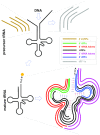On the expanding roles of tRNA fragments in modulating cell behavior
- PMID: 32890397
- PMCID: PMC7515703
- DOI: 10.1093/nar/gkaa657
On the expanding roles of tRNA fragments in modulating cell behavior
Abstract
The fragments that derive from transfer RNAs (tRNAs) are an emerging category of regulatory RNAs. Known as tRFs, these fragments were reported for the first time only a decade ago, making them a relatively recent addition to the ever-expanding pantheon of non-coding RNAs. tRFs are short, 16-35 nucleotides (nts) in length, and produced through cleavage of mature and precursor tRNAs at various positions. Both cleavage positions and relative tRF abundance depend strongly on context, including the tissue type, tissue state, and disease, as well as the sex, population of origin, and race/ethnicity of an individual. These dependencies increase the urgency to understand the regulatory roles of tRFs. Such efforts are gaining momentum, and comprise experimental and computational approaches. System-level studies across many tissues and thousands of samples have produced strong evidence that tRFs have important and multi-faceted roles. Here, we review the relevant literature on tRF biology in higher organisms, single cell eukaryotes, and prokaryotes.
© The Author(s) 2020. Published by Oxford University Press on behalf of Nucleic Acids Research.
Figures



References
-
- Fu H., Feng J., Liu Q., Sun F., Tie Y., Zhu J., Xing R., Sun Z., Zheng X.. Stress induces tRNA cleavage by angiogenin in mammalian cells. FEBS Lett. 2009; 583:437–442. - PubMed
-
- Soares A.R., Santos M.. Discovery and function of transfer RNA-derived fragments and their role in disease. Wiley Interdiscip. Rev. RNA. 2017; 8: - PubMed
Publication types
MeSH terms
Substances
LinkOut - more resources
Full Text Sources
Other Literature Sources
Medical

